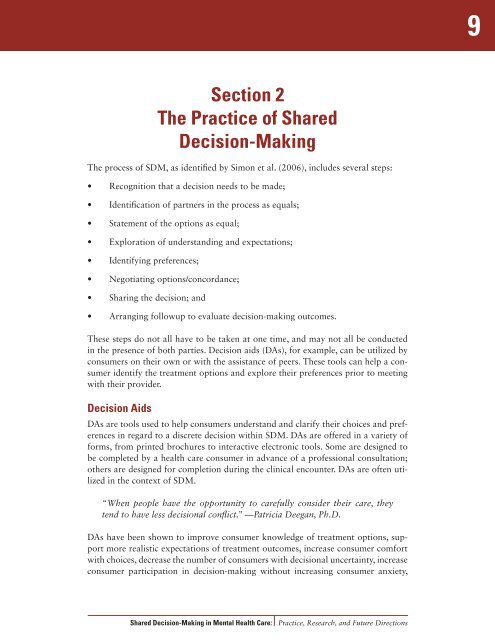Shared Decision-Making in Mental Health Care - SAMHSA Store ...
Shared Decision-Making in Mental Health Care - SAMHSA Store ...
Shared Decision-Making in Mental Health Care - SAMHSA Store ...
Create successful ePaper yourself
Turn your PDF publications into a flip-book with our unique Google optimized e-Paper software.
9Section 2The Practice of <strong>Shared</strong><strong>Decision</strong>-<strong>Mak<strong>in</strong>g</strong>The process of SDM, as identified by Simon et al. (2006), <strong>in</strong>cludes several steps:• Recognition that a decision needs to be made;• Identification of partners <strong>in</strong> the process as equals;• Statement of the options as equal;• Exploration of understand<strong>in</strong>g and expectations;• Identify<strong>in</strong>g preferences;• Negotiat<strong>in</strong>g options/concordance;• Shar<strong>in</strong>g the decision; and• Arrang<strong>in</strong>g followup to evaluate decision-mak<strong>in</strong>g outcomes.These steps do not all have to be taken at one time, and may not all be conducted<strong>in</strong> the presence of both parties. <strong>Decision</strong> aids (DAs), for example, can be utilized byconsumers on their own or with the assistance of peers. These tools can help a consumeridentify the treatment options and explore their preferences prior to meet<strong>in</strong>gwith their provider.<strong>Decision</strong> AidsDAs are tools used to help consumers understand and clarify their choices and preferences<strong>in</strong> regard to a discrete decision with<strong>in</strong> SDM. DAs are offered <strong>in</strong> a variety offorms, from pr<strong>in</strong>ted brochures to <strong>in</strong>teractive electronic tools. Some are designed tobe completed by a health care consumer <strong>in</strong> advance of a professional consultation;others are designed for completion dur<strong>in</strong>g the cl<strong>in</strong>ical encounter. DAs are often utilized<strong>in</strong> the context of SDM.“When people have the opportunity to carefully consider their care, theytend to have less decisional conflict.” —Patricia Deegan, Ph.D.DAs have been shown to improve consumer knowledge of treatment options, supportmore realistic expectations of treatment outcomes, <strong>in</strong>crease consumer comfortwith choices, decrease the number of consumers with decisional uncerta<strong>in</strong>ty, <strong>in</strong>creaseconsumer participation <strong>in</strong> decision-mak<strong>in</strong>g without <strong>in</strong>creas<strong>in</strong>g consumer anxiety,<strong>Shared</strong> <strong>Decision</strong>-<strong>Mak<strong>in</strong>g</strong> <strong>in</strong> <strong>Mental</strong> <strong>Health</strong> <strong>Care</strong>:Practice, Research, and Future Directions
















